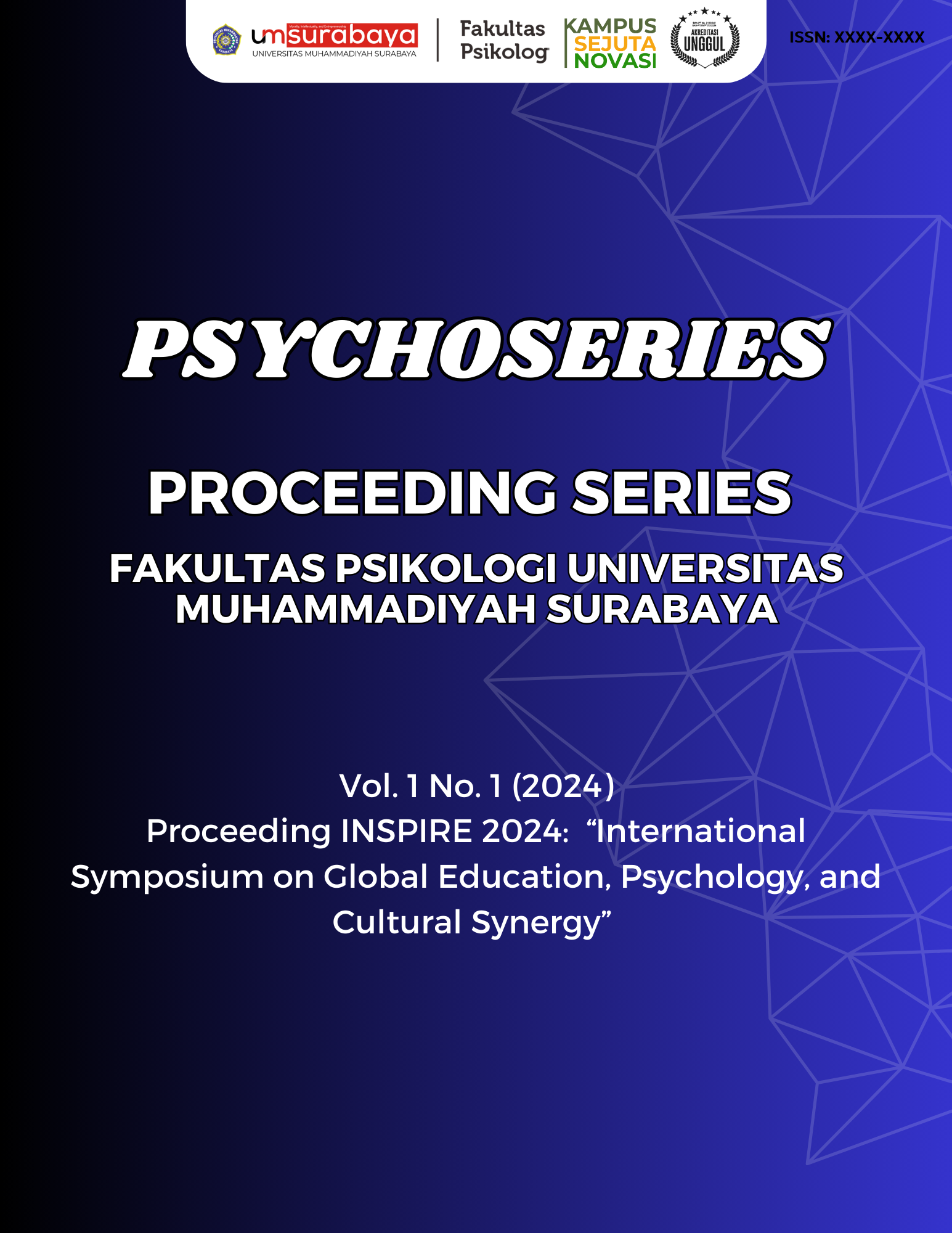The Risk of Attention Deficit Hyperactivity Disorder (ADHD) in Preschool Children
DOI:
https://doi.org/10.30651/psychoseries.v1i1.25259Keywords:
ADHD, Early Detection, PreschoolersAbstract
ADHD symptoms in preschool children have an impact on social development, especially social competence. ADHD symptoms in preschool children will increase oppositional behavior and behavioral problems with peers, making it difficult for children to make friends and establish healthy relationships. Early detection of ADHD risk is important, but the picture of ADHD risk in preschool children is still not widely known. This study aims to obtain a description of ADHD symptoms in preschool children in East Java. This study used descriptive quantitative research with a sample size of 202 preschool children. The instrument to detect ADHD risk is the Abbreviated Conners Rating Scale (ACRS). Data findings were analyzed using univariate analysis. The results of data analysis showed that 30% (60 out of 202) preschool children had ADHD risk. The most common ADHD symptom is Tirelessness, or excessive activity. These findings suggest that ADHD risk detection needs attention at the preschool level.
References
Al-Ahmadi, A. F. R., Fitriany, E., & Wardhana, A. W. (2024). Gambaran Gejala Berdasarkan Skrining Abbreviated Conners Rating Scale pada Pasien Attention Deficit Hyperactivity Disorder Anak di RSUD Abdoel Wahab Sjahranie. Jurnal Kesehatan Andalas, 12(3), 100–105.
Almagor, D., Joseph, L. W., Ansari, R., & Subramaniam, S. (2011). Gender differences and age of diagnosis in ADHD. European Psychiatry, 26(S2), 262–262. https://doi.org/10.1016/S0924-9338(11)71972-1
Arnett, A. B., Pennington, B. F., Willcutt, E. G., DeFries, J. C., & Olson, R. K. (2014). Sex Differences in ADHD Symptom Severity. Journal of Child Psychology and Psychiatry, and Allied Disciplines, 56(6), 632. https://doi.org/10.1111/jcpp.12337
Beauchamp, M. H., & Anderson, V. (2010). SOCIAL: An integrative framework for the development of social skills. Psychological Bulletin, 136(1), 39–64. https://doi.org/10.1037/a0017768
Conners, C. K., Sitarenios, G., Parker, J. D., & Epstein, J. N. (1998). Revision and restandardization of the Conners Teacher Rating Scale (CTRS-R): Factor structure, reliability, and criterion validity. Journal of Abnormal Child Psychology, 26, 279–291.
Denham, S. A. (2006). The Emotional Basis of Learning and Development in Early Childhood Education. In Handbook of research on the education of young children, 2nd ed (pp. 85–103). Lawrence Erlbaum Associates Publishers.
Gardner, D., & Gerdes, A. (2015). A Review of Peer Relationships and Friendships in Youth With ADHD. JOURNAL OF ATTENTION DISORDERS, 19(10), 844–855. https://doi.org/10.1177/1087054713501552
Juniar, S., & Setiawati, Y. (2014). Buku Saku Pedoman Deteksi DIni Gangguan Pemusatan Perhatian/Hiperaktivitas (GPPH). CV. Dwiputra Pustaka Jaya. https://repository.unair.ac.id/107170/2/Buku%20Pedoman%20Deteksi%20Dini%20Gangguan%20Pemusatan.pdf
Krasner, A., Dennis, M., Shoulberg, E. K., Hoza, B., Scott, H., & Martin, C. P. (2022). ADHD Behaviors and Social Functioning in Preschool Children: The Moderating Role of Emotion Recognition. Journal of Psychopathology and Behavioral Assessment, 44(3), 725–737. https://doi.org/10.1007/s10862-022-09957-9
Kurniawati, E. Y., & Ashari, A. (2021). Pertumbuhan, Perkembangan, dan Kesehatan Mental Emosional Anak Pra Sekolah Usia 36-72 Bulan: Studi di KB Kuncup Melati dan TK Pamardi Putra. Jurnal Ilmu Kebidanan, 7(2).
Liu, A., Xu, Y., Yan, Q., & Tong, L. (2018). The Prevalence of Attention Deficit/Hyperactivity Disorder among Chinese Children and Adolescents. Scientific Reports, 8, 11169. https://doi.org/10.1038/s41598-018-29488-2
Martin, J., Langley, K., Cooper, M., Rouquette, O. Y., John, A., Sayal, K., Ford, T., & Thapar, A. (2024). Sex differences in attention-deficit hyperactivity disorder diagnosis and clinical care: A national study of population healthcare records in Wales. Journal of Child Psychology and Psychiatry, 65(12), 1648–1658. https://doi.org/10.1111/jcpp.13987
Nurmalitasari, F. (2015). Perkembangan Sosial Emosi pada Anak Usia Prasekolah. Buletin Psikologi, 23(2), Article 2.
Putri, C. I. H., & Primana, L. (2017). PELATIHAN REGULASI EMOSI ANAK USIA PRASEKOLAH (3-4 TAHUN). Jurnal Pendidikan Anak (WEBSITE INI SUDAH BERMIGRASI KE WEBSITE YANG BARU ==> Https://Journal.Uny.Ac.Id/v3/Jpa), 6(2), Article 2. https://doi.org/10.21831/jpa.v6i2.17706
Salari, N., Ghasemi, H., Abdoli, N., Rahmani, A., Shiri, M. H., Hashemian, A. H., Akbari, H., & Mohammadi, M. (2023). The global prevalence of ADHD in children and adolescents: A systematic review and meta-analysis. Italian Journal of Pediatrics, 49(1), 48. https://doi.org/10.1186/s13052-023-01456-1
Susilowati, L., Hajjar, A. S., & Suryati, S. (2021). Risiko Gangguan Pemusatan Perhatian dan Hiperaktivitas pada Anak Pengguna Gadget. Jurnal Ilmu Keperawatan Jiwa, 4(1), Article 1. https://doi.org/10.32584/jikj.v4i1.810
Tristanti, I., Indanah, I., & Prasetyo, T. I. (2020). Kejadian Gangguan Pemusatan Perhatian Dan Hiperaktivitas (Gpph) Pada Anak Pra Sekolah Di Rsud Dr Loekmonohadi Kudus. Indonesia Jurnal Kebidanan, 4(1), 23–30.
Downloads
Published
How to Cite
Issue
Section
License
Copyright (c) 2025 Widyastuti, Nurul Hartini, Nur Ainy Fardana Nawangsari

This work is licensed under a Creative Commons Attribution-NonCommercial-ShareAlike 4.0 International License.



